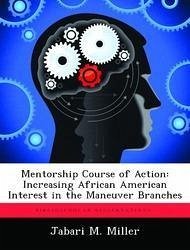Nicht lieferbar

Mentorship Course of Action: Increasing African American Interest in the Maneuver Branches
Versandkostenfrei!
Nicht lieferbar
The maneuver branches have been accessing a relatively low percentage of African American Second Lieutenants in comparison to other branches of the Army. This trend is significant because in the current Army system, a lack of proportional African American participation in the two largest maneuver branches, Infantry and Armor, means that there will likely be a dearth of African Americans holding senior Army leadership positions in the future. This study proposes that the maneuver branches implement a formal mentoring program at the pre-commission sources to address African American bias against...
The maneuver branches have been accessing a relatively low percentage of African American Second Lieutenants in comparison to other branches of the Army. This trend is significant because in the current Army system, a lack of proportional African American participation in the two largest maneuver branches, Infantry and Armor, means that there will likely be a dearth of African Americans holding senior Army leadership positions in the future. This study proposes that the maneuver branches implement a formal mentoring program at the pre-commission sources to address African American bias against serving in Armor and Infantry. This bias is caused by a negative perception of the utility of serving in the branches in seeking to gain skills for a civilian career. The study develops a mentorship program model, and then analyzes it using Army course of action evaluation criteria suitability, acceptability and feasibility. The study finds that the course of action is suitable to the problem, and acceptable, but implementation infeasible due to current operations and moreover maneuver culture. This work has been selected by scholars as being culturally important, and is part of the knowledge base of civilization as we know it. This work was reproduced from the original artifact, and remains as true to the original work as possible. Therefore, you will see the original copyright references, library stamps (as most of these works have been housed in our most important libraries around the world), and other notations in the work. This work is in the public domain in the United States of America, and possibly other nations. Within the United States, you may freely copy and distribute this work, as no entity (individual or corporate) has a copyright on the body of the work. As a reproduction of a historical artifact, this work may contain missing or blurred pages, poor pictures, errant marks, etc. Scholars believe, and we concur, that this work is important enough to be preserved, reproduced, and made generally available to the public. We appreciate your support of the preservation process, and thank you for being an important part of keeping this knowledge alive and relevant.








